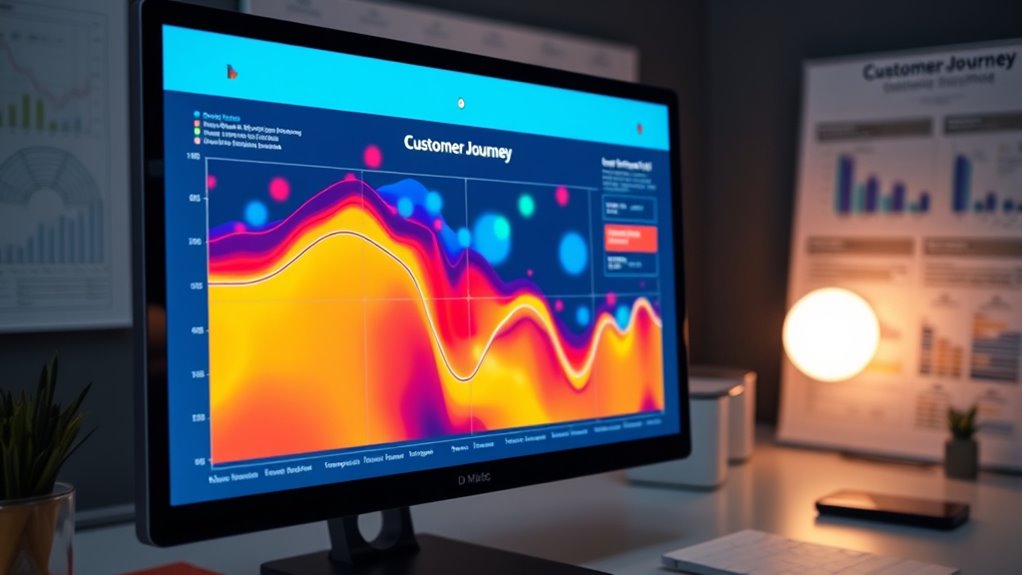To prioritize pain points effectively, rely on heat-mapping data instead of gut feelings. Heat maps show where users engage most, highlighting high-activity areas with bright colors and low-interest spots in cooler shades. Analyzing click patterns, dwell time, and engagement hotspots lets you identify real issues impacting the user experience. Using these insights guarantees your improvements target genuine pain points. Stick around, and you’ll discover how to turn data into impactful actions.
Key Takeaways
- Use heat maps to identify high-activity hotspots and cold spots, revealing true user engagement patterns.
- Analyze interaction data like clicks and dwell time to objectively prioritize pain points.
- Combine quantitative heat map insights with qualitative feedback for comprehensive problem identification.
- Avoid relying solely on intuition; base decision-making on precise, sensor-verified data.
- Continuously monitor post-implementation metrics to validate improvements and refine pain point prioritization.
Understanding the Power of Journey Mapping

Understanding the power of journey mapping is essential because it reveals how customers experience your brand at every touchpoint. When you focus on customer empathy, you gain insights into their needs, frustrations, and motivations, helping you see things from their perspective. This understanding allows you to craft a more meaningful experience. Visual storytelling plays a vital role here, as it transforms complex data into clear, engaging visuals that highlight pain points and opportunities. By mapping out the customer journey, you can identify patterns and emotional responses that might go unnoticed otherwise. This active approach guarantees you’re not just guessing what customers want, but instead making informed decisions based on real insights. Additionally, incorporating voiceover techniques from advertising can enhance how you communicate these insights and engage stakeholders effectively. Ultimately, journey mapping empowers you to create a more customer-centric strategy that builds loyalty and improves overall satisfaction.
The Limitations of Gut-Based Decision Making

Relying on gut feelings can lead you astray because biases and assumptions often cloud your judgment. Inconsistent decision processes make it hard to identify what truly works, and hidden issues can go unnoticed. Recognizing these limitations helps you make more informed, objective choices. Implementing a data-driven approach can further enhance your ability to prioritize pain points effectively.
Biases and Assumptions
Gut-based decision making may feel instinctively reliable, but it often leads to biases and flawed assumptions. Confirmation bias can cause you to focus only on information that supports your existing beliefs, ignoring data that challenges them. Assumption bias makes you jump to conclusions without sufficient evidence, leading to misguided priorities. These biases distort your perception of customer pain points and hinder objective analysis. Relying solely on intuition can cause you to overlook critical insights hidden in the data. Instead of trusting gut feelings, you need to recognize these mental shortcuts and actively seek evidence that confirms or refutes your assumptions. By doing so, you create a more accurate, balanced understanding of customer journeys, enabling better prioritization of pain points based on data rather than subjective biases. Awareness of cookie categories and user consent management practices can help ensure that your data collection remains transparent and compliant with privacy standards.
Inconsistent Decision Processes
Decision-making driven solely by intuition often leads to inconsistent results because it lacks a structured framework. Without a clear process, decision consistency suffers, and your choices become unpredictable. Process variability increases as different team members or departments may interpret situations differently, leading to conflicting actions. Relying on gut feelings can cause you to overlook important data and nuances that guide better decisions. Over time, this inconsistency erodes trust in your decision-making and hampers progress. To improve outcomes, it’s essential to establish standardized processes that reduce variability and promote more reliable, data-driven choices. By moving away from gut-based decisions, you can create a more predictable environment where decisions are aligned, repeatable, and based on solid evidence rather than fluctuating instincts. Incorporating special event planning principles can help structure decision-making around audience engagement and diverse themes, leading to more successful outcomes.
Overlooking Hidden Issues
When decisions are based solely on intuition, it’s easy to overlook underlying issues that aren’t immediately obvious. Relying on gut feeling can blind you to hidden issues and unseen obstacles in the customer journey. These problems might seem insignificant at first but can profoundly impact user experience and satisfaction. Without data, you risk missing patterns that reveal where customers struggle or drop off unexpectedly. Heat-mapping and journey analysis help expose these hidden issues, allowing you to see precisely where customers encounter obstacles. By prioritizing data over intuition, you gain a clearer understanding of true pain points, ensuring you address the root causes rather than just symptoms. Incorporating practical tools into your decision-making process fosters a mindful approach, helping you stay focused amidst the noise.
How Heat-Mapping Visualizes User Interactions

Heat-mapping visualizes user interactions by translating complex data into intuitive color-coded displays that highlight where users focus their attention. Using various visualization techniques, heat maps reveal interaction hotspots—areas on your interface where users spend most of their time or click frequently. These visual cues make it easy to identify patterns and pinpoint problematic zones. Bright colors like red or orange typically indicate high activity, while cooler colors like blue show less engagement. By clearly illustrating user behavior, heat maps help you understand which parts of your journey are most engaging or frustrating. This visual approach allows you to quickly grasp interaction trends without sifting through raw data, enabling smarter decisions to optimize your user experience. For example, analyzing signs of user frustration can help you identify areas needing improvement.
Collecting and Analyzing Heat Map Data

Choosing the right heat map tools is essential for accurate data collection. You’ll want to contemplate effective methods for capturing user interactions and patterns. Once you gather the data, analyzing these interaction trends helps you make informed decisions to improve the user experience. Additionally, understanding expiration indicators can help identify when content or features may need updating or removal to maintain relevance and safety.
Heat Map Tools Selection
Selecting the right heat map tools is essential for accurately collecting and analyzing user interaction data. You should focus on tools that offer a clear and customizable color palette, making it easier to interpret heat intensity and identify pain points quickly. Usability considerations are crucial—look for intuitive interfaces that simplify setup and data review without requiring extensive technical expertise. Compatibility with your existing platforms is also vital to streamline integration and ensure seamless data collection. Additionally, choose tools that provide detailed analytics and filtering options, allowing you to tailor insights to your journey map. By carefully evaluating these factors, you’ll guarantee your heat map analysis is both precise and actionable, empowering you to prioritize user pain points effectively. Incorporating market demand insights can further enhance the accuracy of your analysis and help target the most critical issues.
Data Collection Methods
To effectively collect and analyze heat map data, you need to understand the various methods available for capturing user interactions. Common techniques include embedded sensors, click-tracking, and scroll heat maps. Sensor accuracy is essential; inaccurate data can lead to misguided insights. Choose tools that reliably record precise interactions without missing key actions. Additionally, prioritize data privacy by ensuring user information remains protected throughout the collection process, adhering to relevant regulations like GDPR. Consider whether the method captures extensive data while respecting user consent. Effective data collection balances accuracy with privacy, providing a clear picture of user behavior without overstepping privacy boundaries. It is also important to select headphone compatibility options that do not interfere with sensor data collection, ensuring seamless integration. By selecting appropriate methods, you set a solid foundation for meaningful heat map analysis and informed decision-making.
Analyzing Interaction Patterns
Analyzing interaction patterns involves examining the heat map data to uncover how users engage with your website or app. You’ll spot behavior patterns, such as which areas attract the most attention and where users tend to click or scroll. By studying engagement metrics like dwell time and click frequency, you gain insights into user preferences and pain points. Look for hotspots indicating high activity and cold spots showing neglect. This analysis helps you understand what parts of your journey resonate or cause friction. Identifying these patterns allows you to prioritize improvements based on actual user behavior rather than assumptions. Ultimately, this process enables you to optimize your site’s layout and content for better user experience, guiding your decisions with concrete data instead of gut feelings. Focusing on user engagement ensures that your improvements are grounded in measurable interactions rather than intuition.
Prioritizing Pain Points With Quantitative Insights

Quantitative insights play a crucial role in effectively prioritizing pain points on your journey map. By analyzing data such as conversion rates, drop-off points, and time spent at each stage, you gain a clear view of where users struggle most. These metrics help you identify the most impactful pain points without relying solely on gut feeling. While emotional insights and qualitative feedback provide context, quantitative data objectively highlight the areas needing attention. This approach ensures you focus on issues that affect user experience and business goals most importantly. Prioritizing these pain points based on measurable impact allows you to allocate resources efficiently and make data-driven decisions that improve overall satisfaction and conversion rates.
Implementing Data-Driven Improvements

Once you’ve identified key pain points through data analysis, the next step is to implement targeted improvements that address these issues directly. Use customer feedback and performance metrics to guide your actions, ensuring changes are rooted in real insights. Prioritize solutions that tackle the most critical friction points first, and set measurable goals to evaluate their effectiveness. Communicate these improvements clearly to your team and stakeholders, emphasizing the data-driven rationale behind each decision. Continuously monitor performance metrics after implementing changes to assess progress and identify new opportunities. This iterative process helps refine the customer experience, making improvements more impactful and sustainable. By relying on concrete data rather than intuition, you create a more efficient, customer-centric journey.
Real-World Examples of Heat-Mapping Success

Real-world examples demonstrate how heat-mapping can reveal hidden customer behaviors and optimize the user experience. Case studies show businesses uncover pain points they previously overlooked, leading to targeted improvements. For instance, a retail website used heat-mapping to identify areas where visitors hesitated, prompting layout changes that increased conversions. Success stories like these highlight how data-driven insights reveal user tendencies, rather than relying on assumptions. Another example involves a SaaS company analyzing click patterns to streamline onboarding, reducing drop-off rates profoundly. These real-world examples confirm that heat-mapping provides actionable insights, helping you prioritize pain points based on actual customer interactions. By studying these success stories, you can confidently leverage heat-mapping to enhance your own journey maps and improve overall user satisfaction.
Frequently Asked Questions
How Accurate Are Heat Maps in Identifying User Pain Points?
Heat maps can effectively highlight areas of user behavior, but they have limitations in pinpointing precise pain points. They might show where users click or hover, yet miss underlying issues like confusion or frustration. You should be aware of heat map limitations, as they don’t always capture the full scope of user behavior. To truly understand pain points, combine heat maps with other analytics and qualitative data for a complete picture.
What Tools Are Best for Creating Effective Heat Maps?
Did you know that 85% of users find visual cues like color schemes essential in heat maps? For creating effective heat maps, you should choose tools that offer flexible color schemes and seamless data integration. Tools like Hotjar, Crazy Egg, and FullStory stand out because they let you customize color schemes to highlight pain points clearly, ensuring your insights are data-driven and visually impactful.
How Often Should Heat Map Data Be Reviewed and Updated?
You should review your heat map data regularly, ideally conducting a frequency analysis every few weeks to identify evolving pain points. Update your heat maps based on the latest insights, ensuring your updates reflect current user behavior. The update frequency depends on your website traffic and user interactions, but consistent reviews—at least monthly—help you stay aligned with user needs and prevent outdated information from guiding your decisions.
Can Heat Maps Reveal the Reasons Behind User Frustrations?
Like a modern-day Sherlock Holmes, you can use heat maps to uncover the reasons behind user frustrations. They excel in visual pattern recognition and emotional response analysis, revealing where users struggle. While heat maps show where issues occur, they don’t always explain why. So, combine this data with qualitative feedback to truly understand the root causes and improve user experience effectively.
How Do Privacy Concerns Impact Heat Map Data Collection?
Privacy concerns substantially impact heat map data collection because you need to prioritize user trust. To do this, you should guarantee data encryption to protect sensitive information and always obtain user consent before tracking. This approach not only complies with privacy regulations but also encourages users to feel comfortable sharing their interactions, leading to more accurate heat maps. Respecting privacy ultimately helps you gather valuable insights without compromising user confidence.
Conclusion
You might believe gut feelings guide your decisions, but data proves otherwise. Heat-mapping reveals real user behaviors, helping you pinpoint actual pain points instead of relying on intuition. By trusting this visual, you can prioritize improvements effectively and avoid costly missteps. The truth? Data-driven journey mapping isn’t just a trend — it’s a strategy that turns insights into impactful actions, ensuring your user experience genuinely meets your audience’s needs.









